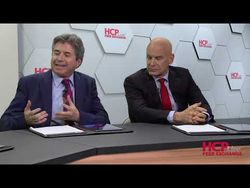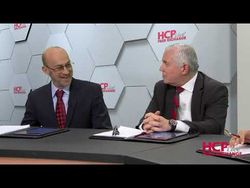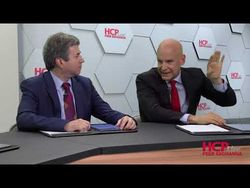Reducing Risk in Cardiovascular Events - Episode 9
The REDUCE-IT Study
Deepak L. Bhatt, MD, MPH: For our audience who may not entirely know what REDUCE-IT is, do both of you on the steering committee want to give a synopsis of the study design and results?
Christie M. Ballantyne, MD: To go back, it was interesting in that this study looked at icosapent ethyl. Think of a fish oil. And Steve, just as correction, there is no OTC [over the counter]; those are supplements. The ones you see in the pharmacy, those are not regulated in the same way that an OTC product is.
Steven E. Nissen MD: We have no idea what they have in them.
Christie M. Ballantyne, MD: Basically we had a mixture of DHA [docosahexaenoic acid] and EPA [eicosapentaenoic acid] that was approved by the FDA. A lot of lipid studies were done with that. Those were used at 1-g studies. Then the EPA was studied for very high triglycerides, for mixed dyslipidemia. Looked to be effective in regard to raising triglycerides, which to me was interesting because we started this back in the 1990s, working with the first formulation. And then in the second one they decided to do an outcomes trial. And so Mike, we were all impressed with that because it was not a big company, and they had only 1 product. Steve, you pointed out that no one had ever done a trial based on high-risk patients with high triglycerides. Basically, document ASCVD [atherosclerotic cardiovascular disease], or diabetes over the age of 50 with 1 additional risk factor. But Deepak, I want you to present the results because you do it better than anybody else.
Deepak L. Bhatt, MD, MPH: That’s kind of you to say. There were 8,000-plus patients as described, secondary prevention, or diabetes and high-risk primary prevention. A bit of a hybrid trial, and what was found overall was 25% reduction in major adverse cardiovascular events, including things like heart attack and stroke and revascularization. Yes, cardiovascular death as well. There was a pretty consistent result in terms of all those components, also hospitalization for unstable angina reduced. Overall the trial was positive, subgroup showing consistent benefit pretty much across the board. So it was a positive study.
Steven E. Nissen, MD: Deepak, I wonder if we could maybe circle back, because there’s a whole class of drugs we haven’t talked about.
Deepak L. Bhatt, MD, MPH: Yeah, there’s a lot we need to cover.
Steven E. Nissen, MD: And the PCSK9 inhibitors.
Deepak L. Bhatt, MD, MPH: Just before that, I’ve just got to turn to Jamie, because you were talking about another trial that is a confirmatory trial, and I think strength is incredibly important scientifically. Jamie, in your role, not just as a physician but as a leader in the National Lipid Association [NLA], as the current president, what are you thinking in terms of implementation and actionability of the REDUCE-IT findings? The guidelines for the NLA have come out with a class 1 indication, which in general means for a patient who is an appropriate candidate, do it.
James A. Underberg, MD, MS: Right. Our recommendations mimic that of the Europeans and the American Diabetes Association. Although your trial data were not available for the recent iteration of the 2018 Guideline here in the US, I think the series of recent recommendations all fit with the enrollment criteria for the trial. How the FDA comes in on the indication side will be interesting. But clearly in this high-risk population of patients who meet the triglyceride findings on enrollment, I think adding 4 g a day of icosapent ethyl is a reasonable intervention in the patients who meet that recommendation. The question is, do you use it instead of some of these other drugs we’re going to talk about or on top of them, as a risk-reducing agent?
Christie M. Ballantyne, MD: Jamie, 1 thing that will maybe bring this back into focus of who is a clinician is starting off in a high-risk patient. We talked about this pretty extensively; you start off with a statin.
James A. Underberg, MD, MS: Yup.
Christie M. Ballantyne, MD: All the guidelines are the same thing. And then you can try to make sure you’ve treated them aggressively enough, depending upon their risk, to get the LDL [low-density lipoprotein] down, at which point you need to remeasure the lipid profile. As we said now, there’s this concept of a threshold. Basically, if their triglycerides are high, we talked about how that would be a patient one could consider EPA, maybe we’ll see in the future other agents with it. But the other 1 ends up—don’t forget about the LDL.
James A. Underberg, MD, MS: What was the LDL in REDUCE-IT? It was low, right?
Deepak L. Bhatt, MD, MPH: Yeah, the average LDL around 70ish mg/dL.
James A. Underberg, MD, MS: Their LDL is well treated.
Deepak L. Bhatt, MD, MPH: With benefits that were consistent across the entire range of LDL we studied, 40 to 100 mg/dL.
James A. Underberg, MD, MS: As Christie points out, this is not in lieu of treating LDL.
Deepak L. Bhatt, MD, MPH: No, I think they’re completely complementary pathways. I think if their LDL is high, get it as low as you safely can.
Christie M. Ballantyne, MD: That’s what comes up, though. If we look at REDUCE-IT, there was 6% on ezetimibe. In the other trials that have been done, they basically had a threshold, they had an LDL of 70 mg/dL or higher, non-HDL [high-density lipoprotein]. Deepak, you were involved with a lot of these others. But the programs—it’s interesting; it’s a field. We look at chronic disorders, hypertension. Everybody uses combination therapy for hypertension, diabetes. Everybody uses combination therapy. When we get to lipids, it’s just people. Basically there’s 1 drug, and we see in all these trials, I’d say around 6% to 8% ezetimibe usage, very little add-on therapy in terms of fibrates or prescription omega-3s. I think it’s time to—we talked about LDL now, but in an era when we’re using combo therapy to knock down blood pressure and diabetes, it’s not happening for LDL either.
Transcript edited for clarity.



